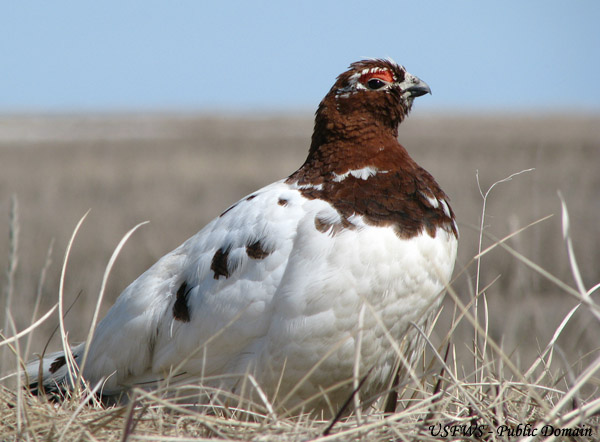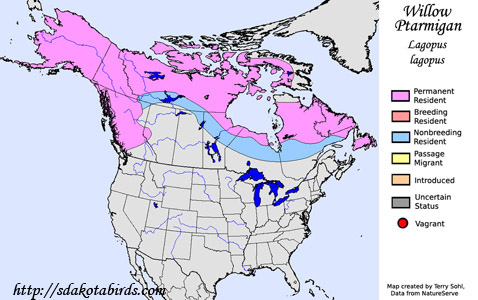| Length: 15 inches | Wingspan: 24 inches | Seasonality: Non-resident in South Dakota |
|
ID Keys: Nonbreeding birds all white. In spring, males develop
dark heads during courtship. In summer, rusty brown upperparts
and white underparts Females: Females a rich brown overall with dark barring underneath, dark spots above |
||
 The
Willow Ptarmigan is the largest of the North American Ptarmigan species, and
are also the most common ptarmigan species. They are well named, as
their preferred habitat are in areas of dwarf willow in the far northern
reaches of North America. A sub-species lives in Great Britain, and
unlike birds in North American which turn all white in the winter, the
British sub-species maintains a brownish plumage all year round.
The
Willow Ptarmigan is the largest of the North American Ptarmigan species, and
are also the most common ptarmigan species. They are well named, as
their preferred habitat are in areas of dwarf willow in the far northern
reaches of North America. A sub-species lives in Great Britain, and
unlike birds in North American which turn all white in the winter, the
British sub-species maintains a brownish plumage all year round.
Habitat: In the northern tundra north of the timberline, Willow Ptarmigan are found in lowland tundra with scattered thickets of dwarf willow. In forested areas in the north, they can also be found in forest clearings and forest edges.
Diet: The Willow Ptarmigan is almost entirely vegetarian as an adult, feeding on dwarf willow and other shrubby trees, including the leaves, buds, and fresh shoots. They also feed heavily on berries when available. The young feed mostly on insects and spiders, but gradually switch to a diet that is primarily vegetarian.
Behavior: Forages by walking along the ground and plucking pieces of vegetation from shrubs and plants.
Nesting: The nest of a Willow Ptarmigan is a shallow depression lined with grasses, moss, and other plant material. The nest is typically at least partially sheltered under a shrub or clump of vegetation. The female alone incubates the eggs. The young leave the nest soon after hatching, and the female will protect them, but the young feed themselves. Unlike other ptarmigan species, the male will also stay with the young after hatching and will help protect them from predators.
Song: The display of a male Willow Ptarmigan has a series of whiny barking calls.
Migration: Considered a permanent resident throughout much of its range. However, some birds do move well south of their breeding range in the winter.
Interactive eBird map: Click here to access an interactive eBird map of Willow Ptarmigan sightings
Similar Species: Rock Ptarmigan, White-tailed Ptarmigan
Conservation Status: The Willow Ptarmigan is generally common throughout much of its range. Its main habitat is often far from human disturbance, and populations are considered strong and stable. The IUCN lists the Willow Ptarmigan as a species of "least concern".
Further Information: 1) Cornell's All About Birds - Willow Ptarmigan
2) State Symbols USA - Willow Ptarmigan
3) Audubon Guide - Willow Ptarmigan
Image Information: Photo by Nathan Graff - U.S. Fish and Wildlife Service - May 25th, 2010 - Yukon Delta National Wildlife Refuge, Alaska - Public Domain photo.
| Click below for a higher-resolution map |
 |
| South Dakota Status: Non-resident in South Dakota |
Additional Willow Ptarmigan Photos (Coming soon)
